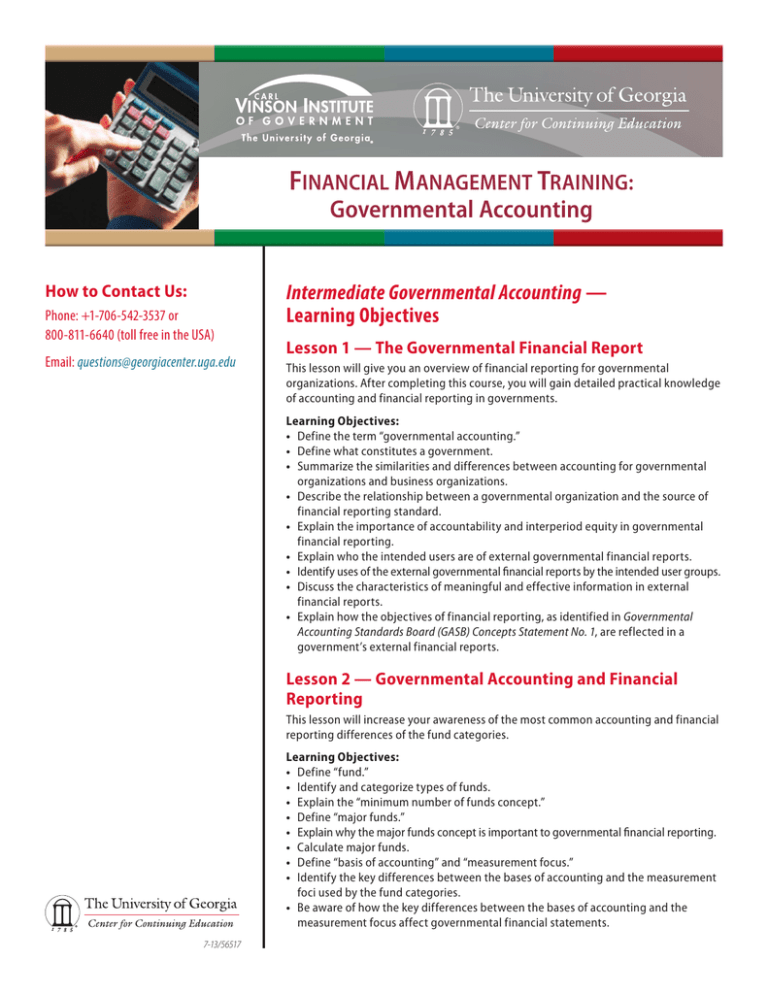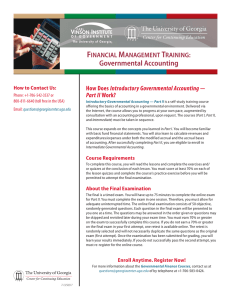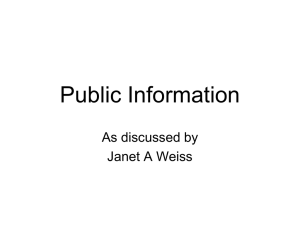F M T Governmental Accounting
advertisement

FINANCIAL MANAGEMENT TRAINING: Governmental Accounting How to Contact Us: Phone: +1-706-542-3537 or 800-811-6640 (toll free in the USA) Email: questions@georgiacenter.uga.edu Intermediate Governmental Accounting — Learning Objectives Lesson 1 — The Governmental Financial Report This lesson will give you an overview of financial reporting for governmental organizations. After completing this course, you will gain detailed practical knowledge of accounting and financial reporting in governments. Learning Objectives: • Define the term “governmental accounting.” • Define what constitutes a government. • Summarize the similarities and differences between accounting for governmental organizations and business organizations. • Describe the relationship between a governmental organization and the source of financial reporting standard. • Explain the importance of accountability and interperiod equity in governmental financial reporting. • Explain who the intended users are of external governmental financial reports. • Identify uses of the external governmental financial reports by the intended user groups. • Discuss the characteristics of meaningful and effective information in external financial reports. • Explain how the objectives of financial reporting, as identified in Governmental Accounting Standards Board (GASB) Concepts Statement No. 1, are reflected in a government’s external financial reports. Lesson 2 — Governmental Accounting and Financial Reporting This lesson will increase your awareness of the most common accounting and financial reporting differences of the fund categories. Learning Objectives: • Define “fund.” • Identify and categorize types of funds. • Explain the “minimum number of funds concept.” • Define “major funds.” • Explain why the major funds concept is important to governmental financial reporting. • Calculate major funds. • Define “basis of accounting” and “measurement focus.” • Identify the key differences between the bases of accounting and the measurement foci used by the fund categories. • Be aware of how the key differences between the bases of accounting and the measurement focus affect governmental financial statements. 7-13/56517 Lesson 3 — Governmental Funds This lesson examines the general rules governing government accounting and financial reporting for governmental funds and how those rules apply in a number of specific situations regularly reported in the activities of governmental funds. Learning Objectives: • Identify exchange and nonexchange revenues reported in governmental funds. • Determine what is classified as an “other financing source.” • Examine the more common asset reporting requirements for governmental funds. • Explain expenditure recognition requirements for governmental funds. • Determine what is classified as an “other financing use.” • Examine the more common liability reporting requirements for governmental funds. Lesson 4 — Proprietary Funds This lesson examines the general rules governing accounting and financial reporting for proprietary funds and how those rules apply in a number of specific situations regularly reported in a government’s activities. Learning Objectives: • Identify who the customers are in enterprise and internal service funds. • Examine how enterprise funds and internal service funds recover the costs of their activities. • Identify what accounting pronouncements enterprise funds and internal service funds are required to follow. • Explain financial reporting requirements in fund financial statements for enterprise funds and internal service funds. • Examine specific guidance as relates for tap fees and connection fees, debt refundings, and customer deposits in enterprise and internal service funds. Lesson 5 — Fiduciary Funds This lesson examines the general rules governing accounting and financial reporting for fiduciary funds and how those rules apply in a number of specific situations regularly reported in a government’s activities. Learning Objectives: • Identify the funds that belong in the “Fiduciary Funds” category. • Explain the difference between fiduciary responsibility and fiduciary funds. • Examine the purpose and characteristics of each of the funds within the fiduciary category. • Explain special accounting issues of each of the fund types within the fiduciary category. • Identify the financial reporting requirements required for each of the fund types within the fiduciary category. Lesson 6 — Financial Reporting and Budgets This lesson examines the budgetary reporting requirements in governmental financial reports. Learning Objectives: • Recall the role of the budget as defined by GASB Concepts Statement No. 1. • Describe the types of budgets used by governments. • Define the differences between generally accepted accounting principles (GAAP) and budgetary basis of accounting. • Discuss how encumbrances affect the budget. • Cite budgetary reporting requirements. Lesson 7 — The Reporting Entity This lesson examines who/what makes up the reporting entity and why some legally separate organizations are included and some are excluded. Learning Objectives: • Recall the reporting rationale of component units, affiliated organizations, and joint ventures. • Understand the definition of a primary government. • Distinguish between a component unit, affiliated organization, joint venture, and jointly controlled governments. • Recognize the reporting requirements of component units, affiliated organizations, joint ventures, and jointly controlled governments. Lesson 8 — External Financial Reporting This lesson examines the required financial components of GASBS No. 34, as amended by subsequent accounting standards issued by the Governmental Accounting Standards Board. In addition, the sections of a comprehensive annual financial report (CAFR) are reviewed. Learning Objectives: • Examine the sections of the comprehensive annual financial report (CAFR). • Identify the minimum required financial statement components under generally accepted accounting principles (GAAP). • Understand the difference between basic financial statements and supplementary information, whether required or optional. • Examine the required content of management’s discussion and analysis (MD&A). • Review the audited financial statements of the State of Georgia as an example of a CAFR. Lesson 9 — Reconciliation — Fund to Government-Wide In order to help you understand the relationship between the two sets of financial statements, GASBS 34 requires summary reconciliations between the fund financial statements and the government-wide financial statements. The nature of the reconciliations can be divided into the following categories: • Reconciliations for governmental activities. • Reconciliations for business-type activities. Learning Objectives: • Define what reconciliations are required by GAAP. • Understand what causes the differences between the governmental fund financial statements and the government activities in the government-wide financial statements. • Recognize the common items required to reconcile government fund equity to government activity net assets (net position). • Recognize the common items required to reconcile the changes in fund balances to the net increase (decrease) in net assets (net position) for governmental activities. • Understand what causes the differences between the proprietary fund financial statements and the business-type activities in the government-wide financial statements. Lesson 10 — Practice Exercise — Reconciliation of Fund Balance to Net Assets The purpose of this practice exercise is to demonstrate the most common differences between the governmental fund balance sheet and the governmental activities in the government-wide statement of net position. This practice exercise provides a method to determine whether you have grasped most of the concepts discussed throughout this course. Lesson 11 — Practice Exercise — Statement of Activities — Governmental Activities The purpose of this practice exercise is to demonstrate the most common differences between the governmental fund Statement of Revenues, Expenditures and Changes in Fund Balance and the governmental activities in the government-wide Statement of Activities. This practice exercise provides a method to determine whether you have grasped most of the concepts discussed throughout this course. Enroll Anytime. Register Now! For more information about the Governmental Finance Courses, contact us at questions@georgiacenter.uga.edu of by telephone at +1-706-583-0424.








